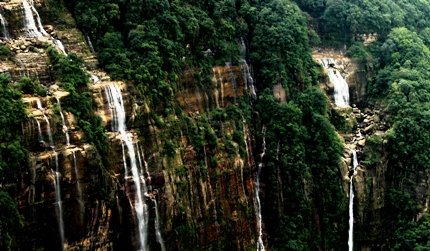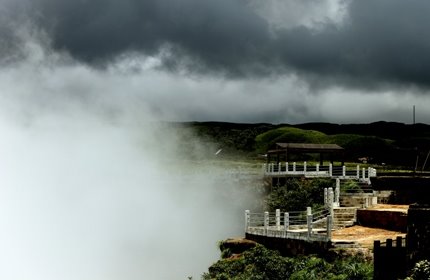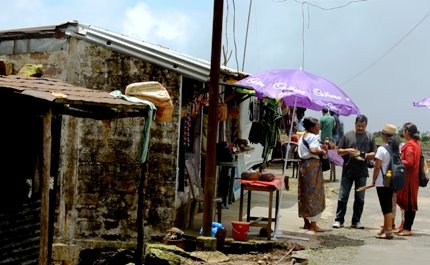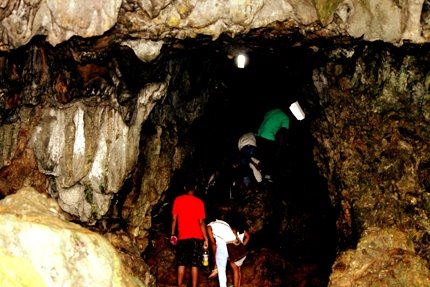Tourist Attractions in Cherrapunjee
Cherrapunjee is a land of exotic natural attractions and unique tribal artifacts... culturally it has a lot to offer to the tourist seeking an unusual experience. The extremely wet climate has propagated a unique species of flora and fauna here and those are showcased in the natural parks. There are marvelous waterfalls, caves and ancient churches that can also capture your interest. You can hire a cab through your hotel or a local tour operator to get around and visit the attractions in Cherrapunjee.
Root Bridges
Double Decker Living Root Bridges
Even if you have seen the living root villages at Riwai village, the ones at Cherrapunjee will still blow your mind by their size and complexity. For the record, Cherrapunjee has the only double decker living root bridges in Asia. Thee roots constructing the bridges grow from old rubber trees that are maneuvered by the Khasis to grow in the form of bridges that stand on top of river. The double decker bridge is actually two bridges stacked on top of each other by the entanglement of roots.
By the way, the trek to the double decker living root bridge is quite tough with 4000 steps but the view and the fairy tale surroundings can make up for it. This is an UNESCO heritage site. There is a spot there called Natural Fish Spa where tourists dip their feet into a natural pool thatís teeming with tiny fish... itís a unique experience as the fish keep touching your feet and remove dead cells. As this is a difficult trek, a guide is necessary along with water, light snacks, energy drinks and a first aid kit.
The Umshiang Double Decker Root Bridge is about 3 km long and its source is at Village Tyrna. The bridge stands at a staggering height of 2400 feet and itís quite a tough job to reach the upper bridge which is 20 meters long. You need to be quite physically fit to reach the upper bridgeÖdonít get fooled by the local khasis who will cross the bridge with utmost ease!!! There are two gigantic iron bridges to cross before you reach the living root bridge and this may sound daunting. It will take you at least 5 hours to complete the double decker living root bridge trek even if you are very fit.
Mawsaw living root bridges with their natural swimming pool is just 30 minutes away from the Umshiang Double Decker Root Bridge.
The Ummunoi Root bridges are single tiered and they are famous for being the oldest living root bridge in Meghalaya, they are at a gentler height of 1400 feet and the bridge is only 74 meter long.
The Ritymmen Root Bridge is in the village of Nongthymmai and will fall on your way if you trek towards the double decker root bridges.
Umkar Root Bridge originates from the Village Siej and it will take you just half an hour to walk across it. This is a spectacular bridge that has a mini waterfall flowing along it in the rainy season.
Waterfalls in Cherrapunjee
Meghalaya is known for its wonderful waterfalls... and Sohra region has some magnificent specimens. Learn more about the top waterfalls in this area.
Seven Sisters Falls
The seven sisters waterfalls are also known as the Nohsngithiang falls and they lie about 1 km south of the village of Mawsmai in the Eastern Khasi Hills. This stunning waterfall falls from a height of 1033 feet and is about 70 meters wide. It has seven segments thus earning itself the name... seven sisters falls.
Seven Sister Waterfall
The waterfall falls from the top of the limestone cliffs of the Khasi Hills during the rainy season and sometimes they catch all the colors of the setting sun creating a kaleidoscope of colors. These waterfalls are in their true form only during the monsoons... otherwise all you can see from the viewpoint beside the road are seven sparkling streams falling from the limestone cliffs. The view here is wider and more spectacular though the falls are of a lower stature as compared to Noh kalikai Falls.
Nohkalikai Waterfalls
Famous as the tallest plunging waterfalls in India, the Nohkalikai Falls has a tragic story behind it. According to legends the waterfall is named after a woman Ka Likai who jumped into its foaming waters after she was grief struck on discovering the death of her baby daughter. The waterfall falls from 1115 feet though itís fed by a relatively small pool of rainwater. The beauty and power of the falls decreases during the dry season between Decembers to February. The water in the Nohkalikai Falls plunges down to collect in an unusual looking green pool of water.
Nohkalikai waterfall under cloud
There is an excellent viewpoint by the road that has a signboard saying Amazong View Point. There is a flight of stone stairs down the slope that reaches a viewpoint thatís 600 feet down the road. If you can reach the rather wild looking overhang that stands at the end of the flight of stairs, you can get an amazing view of the falls. Itís a good idea to wear a raincoat while you are visiting the falls.
Shop at Nohkalikai fall
Dainthein Falls
Take a right turn just before you reach the Cherrapunjee main town and drive on for 10 km more to reach the Dainthein Falls (height 90 meters). The waterfalls derives its name from Thien that means Python in Khasi language. It is said that a huge python used to trouble the people living in Sohra region. So the townspeople captured the python and killed it besides a large rock just next to the waterfall. Today, the ancient carvings depicting the python killing episode near the Dainthien falls attract many visitors.
In the monsoons, the entire cliff is transformed into one large waterfall i.e. the Dainthein Falls. However in drier seasons, you can actually explore the area on foot, dangle your legs in the cold stream water and admire its intense azure like colour. There are small shops around selling tea, coffee and maggii. Be careful of the rather gigantic looking natural potholes that dot the area around the waterfalls.
Wah Kaba Falls/ Canyon Waterfalls
The WahKaba Falls are also known as the canyon waterfalls as the land on which it stands looks like a canyon creating a stunning backdrop for the water that plunges down into the deep gorges below.
If you do want to see the Wah Kaba Falls properly, then make an effort to walk a little further (1 km) to the view point from the designated Meghalaya tourism department parking. There is even a path from where you can climb and down and find a spot to stand over the water passage area and see the falls gushing down. Try viewing the waterfalls from the opposite end as then you can get a 240 degree view of the canyon and the fall.
As you trek down, wonderful views of the valley are available. Some of the steps are a little tricky and you should be careful while handling them. Unfortunately, like in the case of many beautiful waterfalls in Meghalaya... this too dries up as and when the monsoons taper off.
Caves in Cherrapunjee
Meghalaya has the highest numbers of caves in India and there are quite many of them around the Sohra region. Get ready to explore the dark mysterious caves of Cherrapunjee that are full of stalactites, stalagmites and fossils.
Mawsmai Caves
The Mawsmai caves are located about 6 km away from Cherrapunjee and are very famous for their major stalactite and stalagmite formations. There are a wide range of fossils inside the caves which would be a source of interest for both geologists and naturalists. The Mawsmai caves are cavernous, dark and narrow and they arenít for the faint hearted. Some passages are so narrow that bulky people might find it difficult to maneuver themselves in and out of them.
Mawsmai Cave
The path is sometimes full of slippery stones and it is essential to become extremely careful in order to avoid falling. Donít bring in small kids inside the caves... they will find the experience uncomfortable and frightening. Itís anyway advisable to take a guide along who will explain the features of the caves and help to keep you safe.
The caves are long and winding though tourists are only allowed to explore about 200 meters. The sheer variety of stalactites and stalagmites inside the cave will stun you and compel you to wonder about the thousands of years of Godís handiwork that created them.
If you have claustrophobia and/or are sensitive to odor then consider giving the caves a miss as they are quite constrained in parts and have a dank fetid smell.
Arwah Lumshynna Cave at Pdengshnog Sohra
Unlike its more famous cousin, the Mawsmai caves... the Arwah caves are not that difficult to approach. In fact, the approach path to the cave is rather beautiful with lush green vegetation and lovely flowers all around. There are fossils of birds and fish here that are over a million years old. There is also a quick sand pit that remains covered with beautiful blue water and a ďno approachĒ sign.
It will take you 20 minutes to explore the Arwah caves... they were discovered only recently and many of their parts remain unexplored. Once you enter the cave, pay minute attention to the rocks and you will see shapes of fishes and reptiles embedded in them. Some of the rocks look slimy and soft but they are actually stone hard with an eerie yellowish translucent glow.
Itís advisable to carry a pocket torch with you as the lighting inside the cave is not sufficient. Do try to hire a guide as otherwise you will miss out on spotting many of the fossils inside.
U Lum Lawshynna Caves
These caves lie on the slope of the U Lum Lawshynna Hills and itís about 1 km in length. The speciality of this cave is that a stream runs through it till the start to the end creating the impression of walking in a river. The cave is quite high and very wide and it becomes narrower and narrower as you move forward. Many birds and bats frequent this cave and stay here.
A forest called Law Shynna surrounds these caves and it contains many different species of wild flowers, coloured foliage, orchids, bamboos and shrubbery. En route to the cave, you will come across a view point from where you can see the Wahkaba Falls along with the beautiful landscape and river that streams across to Bangladesh crossing the Sohkhmi and the Nongpriang villages. Incidentally, the hill on which the cave is perched is called Lum Shynna and that means Clear View.
Incidentally these hills are a part of the David Scott Bridle Path managed by the British that connects the Valley of Brahmaputra and Surma Valley in Bangladesh. It is interesting to observe the trail and learn about its fascinating history. Look out for the ancient remnants of the Kyntursniang Village in the foothills of the hillock...this is the place where the famous Sohra Syiemship foundation was laid down by Buh Sing Syiem and the myntris.
Mawmluh Caves
The access point to the Mawluh caves is via the lovely river that lies south east of the Sohra Cement Factory. The entrance to the Mawmluh caves is ten feet above the water level and itís a single entrance that leads to two narrow double passages. Intense quarrying of limestone has unfortunately happened above the cave and this has resulted in some portions of the cave caving in. the river enters the cave and water pools in forming lovely little natural pools. This is a long cave stretching out for more than 4500 meters but pollution has marred its beauty. The Mawmluh Caves are known as Kre Mawnluh which is the longest cave in the Indian subcontinent.
Parks and View Points in Cherrapunjee
Mawkdok Dympep Valley View/ Duwan Sing Syiem Bridge
The mawkdok dympep valley view is located at the very beginning of the tourist circuit of Cherrapunjee. It is basically a view point developed by the government. A stunning view of the entire valley till the town of Cherrapunji is available from this point if the skies are clear. However, Sohra being Sohra... clouds are likely to mar the experience.
Zip lining facilities are available here and it costs Rs 300 for a short ride (one way 150 meters) and Rs 500 for a long ride (one way 300 meters). There is also the option of getting a picture clicked after wearing traditional Khasi garments (cost Rs 100 including the photo).
Though this is just a viewpoint... it is exceptional because of the orientation of the view that it offers. The entire cross section of the valley is seen with the V in front of the onlooker... itís worth waiting for a short while for the clouds to clear up for this view!!
Mostly people stop by the Duwan Sing Syeim Bridge to get the view or they climb up to another smaller view point. This is a very popular spot amongst tourists and hence itís likely to be crowded.
Ka Khoh Ramhah
The Ka Khoh Ramhah is right next to the Thangkharang Park of Meghalaya and it lies 13 km away from Sohra town and 10 km away from the Mawsmai caves. Panoramic views of the Sylhet plains of Bangladesh can be seen from this park. A telescope is available here for a one time view (costs Rs 10) and you can see the lovely Umngot River there too.
The Ka Khoh Ramhah is alternatively known as the pillar rock or the Mothorp and its one of the major attractions in Cherrapunjee. The crowning glory of this place is the huge rock thatís shaped like a gigantic cone. There are smaller similarly shaped rocks bordering it. The area surrounding the rock is a nice picnic spot and many tourists flock around this place in the monsoons.
Folklore says that that the rock is the fossil of the cone shaped basket that belongs to an evil giant. In the monsoons, water gushes between the smaller rocks and forms a waterfall which adds to the beauty of the place. Unfortunately, the profuse tourist traffic to the region has resulted in littering and bad maintenance of the place.
Thangkharang Park
Mawsmai Shella Road
Closed on Tuesdays
This park is usually not a part of the tourist circuit of Cherrapunjee and you can go check this out if you have some extra time in Cherrapunjee. The park itself is 12 km away from town and stands right beside the rock of Khoh Ramhah... a stunning 180 degree view of the Bangladesh plains is offered from the view points in the park.
There are two strategically located view points in the park and they are built on rocks. While one offers a great view of the Khoh Ranhah, the other one offers a panoramic view of the entire valley. At one point in the park there is a bridge that crosses over a gushing stream and in the monsoons this spot is quite picturesque. You can see the grand Kynrem falls gushing down in three tiers.
One of the primary attractions of the Thangkharang Park is the Kynrem Falls that is also the 7th highest waterfall in India. This is a 3 tiered waterfall that gushes down from a height of 305 meters. Unlike most other waterfalls, the Kynrem looks just as majestic in the drier seasons too.
The park has a good variety of plants and flowers with some very exotic names. Of special interest is the wide range of orchids that are lovely to look at. The State Forest Department maintains the Park and outside you can find some shops selling souvenirs, handicraft items and snacks. Of special mention are the bamboo kiosk shaped eateries outside which sell indigenous Khasi thalis.
Sa-I-Mika Park
En route to Dainthien Falls
3 km away from Sohra Town
En route to the famous Dainthien Falls and just 3 km before Sohra Town, lies one of the most well known parks of Meghalaya... the Sa-I-Mika Park. It spans across a large area and offers a range of tourist activities along with good accommodation options.
There are two traditional cottages and four double bedded rooms at present in the Sa I Mika Park. While the double bedded rooms charge 1200 per night the traditional cottage comes for 1500 INR per night. The Sa I Mika Park also has a conference hall that can accommodate about 200 people and can host seminars, workshops, concerts and departmental events. Traditional khasi dances, cultural activities, local cooking and local liquor parties are also arranged by the Sa I Mika authorities.
From this park, tourists can trek to the waterfalls and it serves as a good base for trekkers and adventurers. The management has close ties with the local khasi community and it is possible to experience the complete nuances of Khasi life by staying in a homestay in the village.
Eco Park
The Cherrapunji Eco Park is designed and maintained by the Meghalaya Government and it is also one of the cleanest parks in this area. Tourists principally visit the Eco Park for enjoying the beautiful views of the Green Canyons of Cherrapunji that are situated nearby. The park has a lovely clear water stream flowing through its premises. There is a crossover bridge which you can access to reach the very end of the park and viewing the green canyons.
The other side of the park provides a panoramic view of the Sylhet plains of Bangladesh. Inside the park there is a green-house containing a large variety of orchids and plants donated by the Shillong Agri Horticultural society. The southern area of the park is the source point of the famous Nohsngithiang Falls. Kids will specially enjoy this place because of the interesting man made constructs and the play area containing swings and slides.
Monuments and Places of Religious Significance in Cherrapunjee
The history of Cherrapunjee is chequered over with exploits of Khasi warriors, work of Christian missionaries and strong Hindu religious activities. There is a fusion of faiths here that is demonstrated by the various monuments of religious interest in Cherrapunjee.
Khasi Monoliths
Monoliths are gigantic single stone structures erected as memories of warriors. These are found in several points in Sohra including near the Mawsmai Caves. If you are visiting the Mawphalang Forest then you will be able to check out Monoliths there too.
The vertical monoliths represents the males while horizontal ones represent the females. Itís surprising to see that few locals have a clear idea about their historical significance and the stories surrounding them. Watch out for the signboard near the Mawsmai Caves... they explain a lot. For the record, the most impressive cluster of Monoliths in Meghalaya is in the Nartiang Village in the Jaintia Hills... you should definitely go if you are a history/ archaeology lover.
Ramakrishna Mission Ashrama
Cherra Bazar, Cherrapunjee, Meghalaya,
Phone: 03637 235 242
Known by the rather cool nickname ďRKM CherraĒ this institution was established in 1924 by Swami Vivekananda and is now considered to be an important tourist attraction of Cherrapunjee. The Ahrama is large and sprawling encompassing schools, temple, play area, auditorium and information centre. Like the other Ramakrishna missions this centre too imparts education in line with moral values like patriotism, honesty, sincerity and purity.
The building is rather Anglican looking and has a red and white colour scheme... its setting against acres of greenery is picturesque and will certainly compel you to look awhile. The RKM Cherra operates a chain of nearly 15 schools across the NE region and aims to foster education as well as the spirit of national integrity.
Don Bosco Shrine
Next to Ram Krishna Mission
Cherra Bazaar
Itís quite easy to spot the Don Bosco shrine as it is right near the Ramakrishna Mission in Cherrapunji bazaar. The Salesians who had a deep influence and affinity for the Sohra-Shillong belt had expressed their wish to erect a monument in the fond memory of their Patron... Don Bosco in 1934 during the canonisation ceremony of a saint in St Peters Rome. Today Sohra with its 12,000 plus Catholics claims the only Don Bosco shrine in India and the Cherrapunji mission runs 7 ME and 52 LP schools in different areas along with apprenticeship schemes.
The don Bosco shrine at Sohra has the sacred casket containing the remnants of Don Bosco and thatís a major attraction of this place. The monument is mid statured and has an austere kind of beauty that is augmented by its beautiful surroundings.
Presbyterian Church
Nongswlia
2 km south of Cherrapunjee
This is the first church that the missionaries opened in Meghalaya and it was built way back in 1845. The church is serene, ancient and has an idyllic feel about it. Look out at the road opposite to the church... there are original Welsh style houses which are more than 100 years old. This is a heritage site and has lovely architecture that is a representation of the British Colonial Style. The Church is also known as Calvinistic Methodist Church and was established by the first missionary to Sohra Rev Thomas Jonas and his wife Anne Thomas.
Donít miss out reading the illustrations that explain the activities of Baptist missionaries in the Khasi Hills over centuries... its explained very nicely in signage inside the park. The surroundings of the Church is very beautiful with rolling green fields and cloud clad mountains.
Do stop over to see the tombs of the Welsh missionaries that stands on a small hillock just opposite to the church. The unique style of architecture and the inscriptions will fascinate you.
Ka Kper Syiem Sohra
Eastern Khasi Hills
En-route from Shillong to Cherrapunjee
If the history of Cherrapunjee interests you then you can consider visiting the Ka Kper Syiem Sohra thatís the official cremation ground of Sohra Syiemship. This place lies by the side of the Pomsohmen stream.
Itís interesting to note the intricate and expensive procedures which accompany the cremation of Syiem. It is said that the body of a Syiem is kept for many years if the required formalities are not performed by the elect of the Syiem. Look out for the signage inside the ground that explains the intricacies of the cremation process.
The cremation ground marks the entry point to Cherrapunjee and it offers a wonderful view of the Khasi Hills gorges. The waterfalls of this region especially the seven sisters waterfall is very famous.
Related Articles
|
Visitors' Reviews/Comments
|



